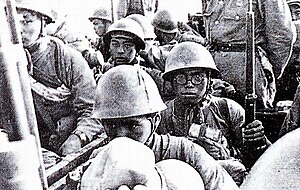자오양 전투-이창
Battle of Zaoyang–| 자오양 전투-이창 | |||||||
|---|---|---|---|---|---|---|---|
 자오양이창 전투의 일본군 | |||||||
| |||||||
| Belligerents | |||||||
| | | ||||||
| 지휘관 및 지도자 | |||||||
| | | ||||||
| 힘 | |||||||
| 350,000 | IJA 11군 탱크 200개 이상 100대 이상의 항공기 제1중국원정함대 | ||||||
| 사상자 및 손실 | |||||||
| 일본 기록:
| 중국 기록: 11,000명 사망
| ||||||
자오양 전투-이창은 조이 전투(중국어: 棗宜會戰)로도 알려져 있으며, 청일 전쟁 동안 국가 혁명군과 일본 제국군 사이의 22개의 주요 전투 중 하나였습니다.
배경
일본인들은 중국의 항복을 얻어내기 위해 더 빠른 해결책을 찾고 있었습니다. 일본인들은 양쯔강 아래로 곧장 이전한 중국의 수도 충칭으로 이동하는 것을 고려했습니다. 그러기 위해서는 후베이성 서부의 중요한 도시인 이창을 점령해야 합니다.
일본군의 공격으로 많은 병력이나 물자가 투입되지 않았고, 이로 인해 이전에 일본군을 좌절시켰던 중공군의 주요 지휘관 리종렌은 일본군을 격퇴할 수 있었습니다.
전투
1940년 5월 1일, 소노베 와이치로가 지휘하는 제11군단의 3개 사단이 자오양을 향해 진군을 시작했습니다. 이들은 통바이산과 다홍산 산맥의 제5전구 거점을 향해 진격해 당엔보 장군 휘하의 중국 제31군단을 포위, 격파하려 했습니다. 중국의 전략은 창사 전투에서 성공적으로 사용된 것처럼 일본군의 보급품이 부족하도록 한 다음 반격하는 것을 목표로 했습니다. 일본군이 가까스로 당나라 군대를 물리치자 장즈중 장군은 중국 제33군단과 함께 그를 돕기 위해 진군했습니다. 일본군은 중국군을 규합하여 후퇴시켰고, 장즈중 장군은 전선에서 퇴각하기를 거부하면서 기관총을 터뜨려 격추당했습니다. 그는 전쟁 중에 전투 중에 전사한 가장 고위급 중국 지휘관이었습니다.[1]
일본군은 화학무기가 부족한 중국군을 상대로 화학무기를 사용해 수적으로 열세에 처했을 때 이를 보완했습니다. 미국인들은 화학무기를 비축하고 있었고 일본인들은 보복을 두려워했기 때문에 일본인들은 미국인들에게 가스를 사용할 엄두를 내지 못했습니다.[2][3][4]
1941년 이창 전투처럼 일본군이 일본군을 격파하고 압도하면서 일본군은 중국군을 상대로 가스 공격을 감행했는데, 이 전투에서 일본군은 도시의 지상군을 중국군에 의해 격파했지만 일본군은 겨자 가스를 사용해 승리했습니다.[5][6][7][8][9]
후폭풍
일본의 기록에 따르면, 일본군의 사상자는 2,700명의 전사자와 7,800명의 부상자였습니다. 중국의 기록에 의하면 11,000명의 일본군이 목숨을 잃었다고 합니다. 중국 제5전구는 거의 틀림없이 전투 계획에서 전술적으로 타당한 결정을 내렸지만, 궁극적으로 일본 연합 무기 공세의 순수한 화력에 압도되었고, 주로 작은 무기에 의존하여 일본 공군, 해군, 포병 및 기갑 공격력의 공격을 받았습니다. 중국군 사령관들이 추측한 대로 일본군은 지나치게 확장되어 승리를 추구할 위치에 있지 않았습니다. 그러나 일본 제국 해군은 쓰촨성의 변방에 위치하고 제5, 제9전구를 연결하는 이창 점령을 강력히 추진했습니다. 해군은 충칭에 대한 공습을 위한 전진기지로서 매우 필요하다고 느꼈습니다. 상당한 논쟁 끝에 일본군은 이창을 점령하기로 합의했습니다.[1] 이 작전 이후 대규모 공세가 전개되지 않아 중국군의 사기와 전투력에 상당한 타격을 입혔습니다.[10]
참고 항목
참고문헌
- ^ a b Frank, Richard (2020). Tower of Skulls: A History of the Asia-Pacific War, Volume I: July 1937-May 1942. W. W. Norton & Company. ISBN 978-1324002109.
- ^ Grunden, W.E. (2017). "No Retaliation in Kind: Japanese Chemical Warfare Policy in World War II". In Friedrich, B.; Hoffmann, D.; Renn, J.; Schmaltz, F.; Wolf, M. (eds.). One Hundred Years of Chemical Warfare: Research, Deployment, Consequences. Springer. pp. 259–271. doi:10.1007/978-3-319-51664-6_14. ISBN 978-3-319-51664-6. S2CID 158528688.
- ^ https://researchgate.net/publication/321329919_No_Retaliation_in_Kind_Japanese_Chemical_Warfare_Policy_in_World_War_II[맨 URL]
- ^ Hammond, James W. (1999). Poison Gas: The Myths Versus Reality. Praeger Security International (illustrated ed.). Greenwood Publishing Group. p. 50. ISBN 0313310386. ISSN 0883-6884.
that raid was the Japanese decision to extend her defense perimeter to include the Solomon Islands . ... In three days of hand - to - hand fighting from blockhouse to blockhouse , Tarawa was " USMC entirely " ( a paraphrase of the ...
- ^ United States. War Department. Military Intelligence Division (1944). Enemy Tactics in Chemical Warfare. War Department. p. 81-83.
The order set up within an infantry regiment a temporary gas unit , consisting of eight squads , whose duty was to carry ... or on occasion thrown by hand , the Japanese also have toxic smoke ( vomiting gas ) candles which are self ...
- ^ Index to Intelligence Publications. ContributorUnited States. War Department. Military Intelligence Division. Military Intelligence Division, War Department. 1944. p. 81-83.
The gas squads were to be attached to forward companies or place under their direct command , and the importance of ... and tear gas candles , designed to be placed on the ground and burned , or on occasion thrown by hand , the Japanese ...
{{cite book}}: CS1 유지보수: 기타(링크) - ^ United States. War Department. General Staff (1944). Special Series, Issue 24. U.S. Government Printing Office. p. 81-83.
The order set up within an infantry regiment a temporary gas unit , consisting of eight squads , whose duty was to carry ... or on occasion thrown by hand , the Japanese also have toxic smoke ( vomiting gas ) candles which are self ...
- ^ Hooper, Franklin Henry, ed. (1942). Britannica Book of the Year. ContributorWalter Yust. Encyclopaedia Britannica, Incorporated. p. 172.
After a fierce four - day hand - to - hand combat the Chinese recaptured Ichang . When the Japanese used gas to attack Ichang , according to Chungking , the Chinese forces withdrew on Oct. 13. The Chinese and Japanese military situation ...
- ^ Britannica Book of the Year Omnibus [1942]. ContributorsWalter Yust, Encyclopaedia Britannica, inc. Encyclopædia Britannica. 1943. p. 353.
After a fierce four - day hand - to - hand combat the and naval fire occupied six different points stretched over a dis- Chinese recaptured Ichang . When the Japanese used gas to tance of 250 mi . along the Kwangtung coast , and at the ...
{{cite book}}: CS1 유지보수: 기타(링크) - ^ Central China area operation record 1937-1945 (PDF) (Report). Japanese Monograph. Vol. 179. Tokyo, Japan: Headquarters, USAFFE and eighth U.S. Army, Office of the chief of military history department of the army. 21 December 1955. pp. 215–218. Retrieved 8 February 2018.
원천
- 쉬룽쉰과 장밍카이, 중일전쟁사(1937~1945) 제2판, 1971. 원하슝 옮김, 정우출판; 중화민국 타이베이 퉁화거리 140번길 33. 334-339페이지, 지도 20, 21
- 반 드 벤, 한스. 중국의 전쟁과 민족주의: 1925-1945,

